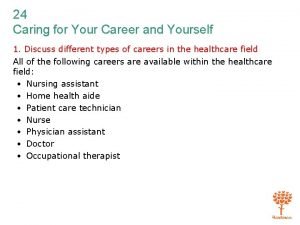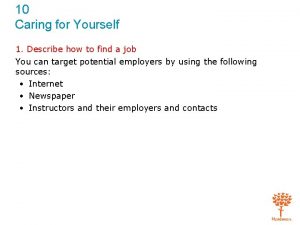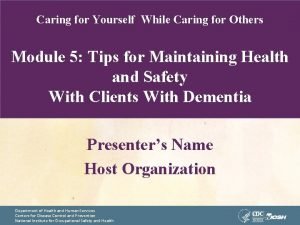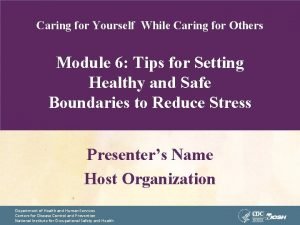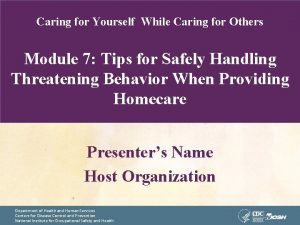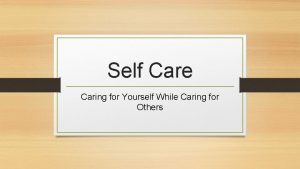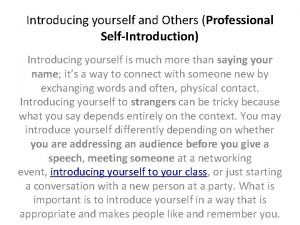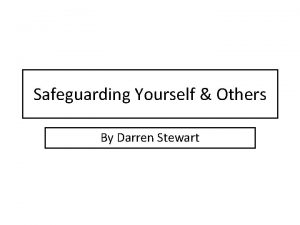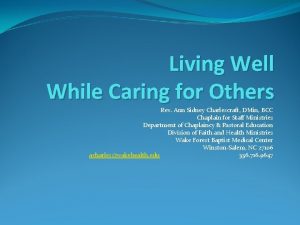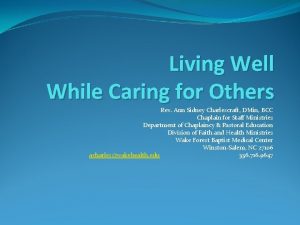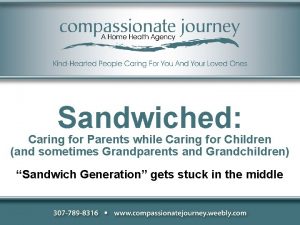Caring for Yourself While Caring for Others Module

















![Credits • [Insert trainer and/or training organization’s name(s), and contact information here. ] Department Credits • [Insert trainer and/or training organization’s name(s), and contact information here. ] Department](https://slidetodoc.com/presentation_image_h/9910ab8f9a87e5ff6cf0391e24778787/image-18.jpg)
- Slides: 18

Caring for Yourself While Caring for Others Module 4: Tips for Reducing Exposure to Bloodborne and Other Infectious Diseases Presenter’s Name Host Organization Department of Health and Human Services Centers for Disease Control and Prevention National Institute for Occupational Safety and Health

Department of Health and Human Services Centers for Disease Control and Prevention National Institute for Occupational Safety and Health

Session Goals Participants will be able to do the following: • Identify the key steps of Standard Precautions. • Outline the pathways through which homecare workers are exposed to risks from bloodborne and other infectious diseases. • Describe strategies and tools to reduce risks. • Follow positive problem-solving steps with clients. Department of Health and Human Services Centers for Disease Control and Prevention National Institute for Occupational Safety and Health

Standard Precautions—Key Steps 1. Frequently wash hands or use alcohol-based handrubs. 3. Wear an apron, mask, and eye protectors as necessary. 4. Properly handle and dispose of possibly infected linens and wastes. 5. Properly handle and dispose of sharp instruments, such as needles. Department of Health and Human Services Centers for Disease Control and Prevention National Institute for Occupational Safety and Health Illustration by ®Mary Ann Zapalac 2. Use gloves.

Bloodborne and Other Common Infectious Diseases Bloodborne Diseases: • HIV/AIDS. • Hepatitis B and C. Other Common Infectious Diseases: • Viral: • Bacterial: – Influenza, or the flu. – “Staph” skin infection. – Respiratory infections. – Pneumonia. – Diarrhea. – Urinary tract infection. – Chickenpox, measles, • Parasitic—Giardia mumps. diarrhea. Department of Health and Human Services Centers for Disease Control and Prevention National Institute for Occupational Safety and Health

Understanding How Infectious Diseases Spread Where Infection Lives Blood or Body Fluids: • • • Urine Feces Tears Phlegm Saliva Department of Health and Human Services Centers for Disease Control and Prevention National Institute for Occupational Safety and Health • • Vomit Sweat Semen Vaginal fluid • Food • Water • Organic matter • Pets • Pests

Pathways Through Which Infectious Diseases Spread • Being stuck by a sharp with infected body fluids. • Breathing spray from coughs, sneezes, talking. Photo by ®Thinkstock • Touching infectious people—or surfaces, objects, clothing, and linens that carry body fluids. • Eating, drinking, or handling infected food, water, or dirt. • Being bitten by animals and insects, or by coming into contact with animals’ body fluids. Department of Health and Human Services Centers for Disease Control and Prevention National Institute for Occupational Safety and Health

People may have any of a variety of symptoms: • Fever or chills. • Loss of appetite. • Fatigue. • Aches and pains. • Diarrhea or other bowel problems. • Difficulty breathing. • Rashes, jaundice. Department of Health and Human Services Centers for Disease Control and Prevention National Institute for Occupational Safety and Health Photo by ®Thinkstock What Symptoms Suggest a Person Has an Infectious Disease? Or, they may have no observable symptoms at all!

• Babies, children, and elders. • People who are sick. • Those with pre-existing conditions and weak immune systems. • Those with don’t eat a healthy diet. • Those with poor personal hygiene or living conditions. • Those who are over-tired or stressed. • Those who don’t wash their hands often. Department of Health and Human Services Centers for Disease Control and Prevention National Institute for Occupational Safety and Health Photo by ®Thinkstock Who is at Most Risk of Becoming Ill When Exposed to Infection? Anyone CAN be at risk!

Because Clients are Often at Great Risk of Becoming Ill … Homecare workers need to … • Always cover their mouths and noses when sneezing or coughing—using tissue or their upper sleeve or elbow. • Always wash their hands or use alcohol handrub after coughing or sneezing. Department of Health and Human Services Centers for Disease Control and Prevention National Institute for Occupational Safety and Health Photo by ®Thinkstock • Avoid coming to work when they are sick.

Illustration by ®Mary Ann Zapalac What Advice Would You Give Ana? Ana is a homecare worker who has read a handout she picked up at a health fair on bloodborne and infectious diseases. She’s feeling afraid of continuing to do her work. She worriedly exclaims, “There are so many ways we can get sick! And there are so many illnesses we can be exposed to! How can I feel safe working in clients’ homes? ” What advice would you give her? Department of Health and Human Services Centers for Disease Control and Prevention National Institute for Occupational Safety and Health

Tips for Staying Healthy and Safe Around Infectious Diseases • Use all Standard Precautions! • Get other vaccines—such as for Hepatitis B—as needed. • Don’t go to work if you are sick. • Avoid sharing drinking cups, bottles, eating utensils, and other food items. • Encourage everyone to cough or sneeze into a tissue or their upper sleeve—and do it yourself! Department of Health and Human Services Centers for Disease Control and Prevention National Institute for Occupational Safety and Health Photo by ®Thinkstock • Be sure to get a flu shot every year.

Tips for Staying Healthy and Safe Around Infectious Diseases • Use a fresh bleach solution to carefully clean surfaces that may be infected. Photo by ®Thinkstock • Bandage cuts, sores, or breaks on your own skin and on clients’ skin (unless doctor says no). • Take in only necessary equipment and supplies. • Do not do tasks in ways or circumstances Department of Health and Human Servicesthat may expose you to Centers for Disease Control and Prevention National Institute for Occupational Safety and Health infection. Photo by ®Thinkstock • Avoid setting objects such as purses and bags on potentially infected surfaces.

Tips for Staying Healthy and Safe When Handling Sharps • Discard sharps immediately after use into an approved sharps container. Never put sharps in a regular recycling bin or trash can. • Never reach blindly into a trash bag, behind furniture, or into other areas where sharps might be. • Never recap a needle or touch the point. Department of Health and Human Services Centers for Disease Control and Prevention National Institute for Occupational Safety and Health Illustration by ®Mary Ann Zapalac • Handle sharps with extreme care. Point sharps away from your body.

• Use disposable gloves and heavy-duty plastic bags when handling soiled laundry. • Tie laundry bags shut and make sure they don’t leak. • Don’t fill bags with too much laundry. It might cause you to trip and fall, or the bags might break open. Department of Health and Human Services Centers for Disease Control and Prevention National Institute for Occupational Safety and Health Illustration by ®Mary Ann Zapalac Tips for Staying Healthy and Safe When Handling Soiled Laundry

Talk it Over! Bring up health and safety issues as soon as possible. • Plan the discussion. • Be respectful—make a request, not a demand. • Use “I” statements. Describe your health and safety concern, how it affects you, and what the impact might be on you and the client. • Listen. See the issue from the client’s point of view. • Consider several solutions beyond your first choice. • Know your bottom line. Department of Health and Human Services Centers for Disease Control and Prevention National Institute for Occupational Safety and Health

Thanks for Your Great Participation! Additional Resources: • Homecare workers’ handbook: Caring for Yourself While Caring for Others. http: //www. cdc. gov/niosh/docs/2015 -103/pdf/2015 -103. pdf • NIOSH Hazard Review: “Occupational Hazards and Home Health Care. ” http: //www. cdc. gov/niosh/docs/2010 -125/pdfs/2010 -125. pdf • Home and Community Health Worker Handbook, British Columbia, Canada, OHSAH. http: //www. phsa. ca/NR/rdonlyres/6 C 69 D 638 -8587 -4096 -A 8 AA 7 D 2 B 0141 C 3 B 2/59614/Handbook. Homeand. Community. Healthcare. W orkers. Handbook. pdf • Safety Manual for Homecare Workers, Oregon Homecare Commission. http: //apps. state. or. us/Forms/Served/de 9062. pdf Department of Health and Human Services Centers for Disease Control and Prevention National Institute for Occupational Safety and Health
![Credits Insert trainer andor training organizations names and contact information here Department Credits • [Insert trainer and/or training organization’s name(s), and contact information here. ] Department](https://slidetodoc.com/presentation_image_h/9910ab8f9a87e5ff6cf0391e24778787/image-18.jpg)
Credits • [Insert trainer and/or training organization’s name(s), and contact information here. ] Department of Health and Human Services Centers for Disease Control and Prevention National Institute for Occupational Safety and Health
 Dr. jean watson
Dr. jean watson Chapter 31 caring for your career and yourself
Chapter 31 caring for your career and yourself Chapter 10 caring for yourself
Chapter 10 caring for yourself Chapter 24 caring for your career and yourself
Chapter 24 caring for your career and yourself Motivating yourself and others
Motivating yourself and others Chapter 6 lesson 2 respecting yourself and others
Chapter 6 lesson 2 respecting yourself and others Yourself themselves
Yourself themselves Ict in education images
Ict in education images Know yourself to lead yourself
Know yourself to lead yourself Check yourself before you wreck yourself origin
Check yourself before you wreck yourself origin Why are some countries poorer than others
Why are some countries poorer than others Do while loop adalah
Do while loop adalah C device module module 1
C device module module 1 Vilken grundregel finns det för tronföljden i sverige?
Vilken grundregel finns det för tronföljden i sverige? Verktyg för automatisering av utbetalningar
Verktyg för automatisering av utbetalningar Bamse för de yngsta
Bamse för de yngsta Plats för toran ark
Plats för toran ark Vad är hsil
Vad är hsil Nyckelkompetenser för livslångt lärande
Nyckelkompetenser för livslångt lärande

